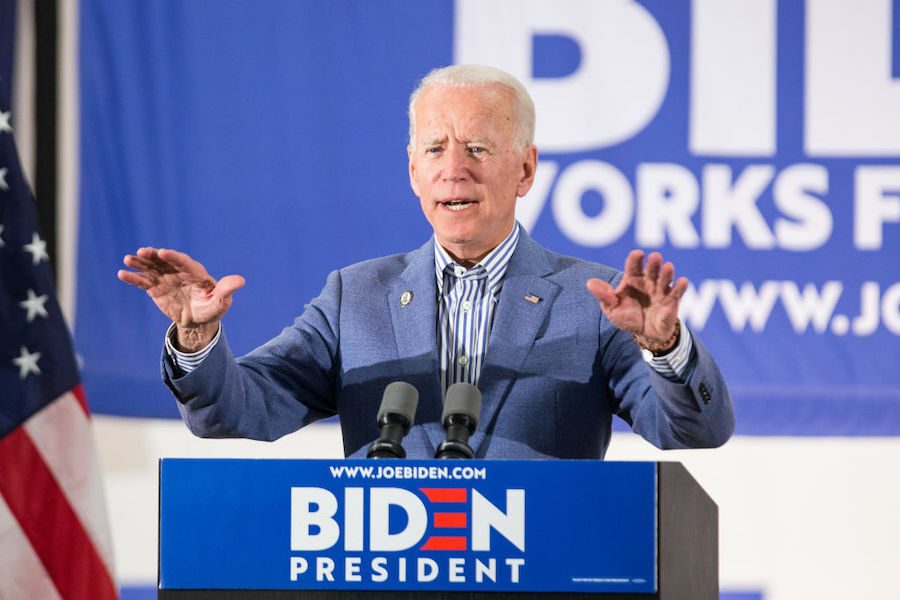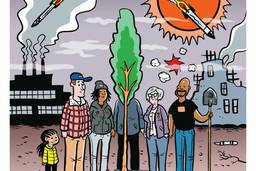Hold the Applause. Biden’s Climate Plan Is Mostly Fluff.
Biden avoids taking on the fossil fuel industry by relying on vague promises and unproven technologies.
Dayton Martindale

When I first skimmed the section headers of Joe Biden’s climate plan on Tuesday, my eyes glossing past most of the details, I came away cautiously optimistic. While I wished his goals were more ambitious, I was heartened to see even a relative moderate like Biden calling for an end to fossil fuel subsidies, a vast expansion of protected lands and $1.7 trillion in climate investment over the next 10 years. That seemed like a win.
Later in the afternoon, however, I took the time to read the whole thing more closely, and my optimism turned to disappointment. The 10,000-word plan covers a lot of ground — including somewhat arbitrary forays into the science of the greenhouse effect, Biden’s record, and steps already taken by city and state governments to address climate change — giving the appearance of a monumental document. But once you look beneath the puff, it becomes clear the plan is not grounded in robust proposals, and the substance is remarkably flimsy. His good ideas (like ending subsidies) are mostly shared by the rest of the Democratic field; he puts undue faith in new technologies, hoping they can save us without having to directly confront the fossil fuel industry; and the regulations he suggests are generally either mild or toothless — likely not enough to achieve his stated goals, themselves insufficient to stem the crisis.
Lack of specificity is not, in itself, disqualifying. The Green New Deal resolution, as introduced in Congress by Rep. Alexandria Ocasio-Cortez (D-N.Y.) and Sen. Ed Markey (D-Mass.), is much more a statement of goals and principles than an actual plan. Any comprehensive climate plan will ultimately require input from Congress, and from environmental, labor and community organizations; the president won’t and shouldn’t write the whole thing on their own. But Biden’s goals leave much to be desired, and many of the solutions he does propose are either woefully insufficient, doomed to failure or both. The Green New Deal begins to sketch out a genuine economic transformation; Biden’s plan seems designed to salvage the status quo. While climate activists and scientists are increasingly doubtful that modest market-based actions can reduce emissions at the speed we need, Biden is trying sell such a moderate approach to the public.
A Green New Deal?
In the last month, Joe Biden has taken a lot of heat on climate change. On May 10, Reuters reported that Biden climate adviser Heather Zichal — formerly on the board of a natural gas company — said the campaign was searching for a “middle ground” on climate change. Environmental organizations pummeled Biden over this compromise strategy, and Bernie Sanders turned “#NoMiddleGround” into a hashtag. Then Greenpeace gave Biden a D-minus in its candidate scorecard released May 30, narrowly edging out John Hickenlooper to place 18th out of 19 Dems. And in a June 3 Washington Post article surveying the Democratic candidates on climate policy, Biden was cited as the only one without a stance on the Green New Deal, declining to answer any of the Post’s questions.
In his new plan, some of this appears to change. He calls the Green New Deal a “crucial framework,” and says that his plan shares two important principles with the GND: “(1) the United States urgently needs to embrace greater ambition on an epic scale to meet the scope of this challenge, and (2) our environment and our economy are completely and totally connected.”
Other such radical-sounding rhetoric peppers the plan, including an explicit call to “go well beyond the Obama-Biden Administration platform.” To hear this from an establishment-backed frontrunner looks like progress. The Sunrise Movement, a youth-led climate group that has been advocating a Green New Deal, claimed victory in a press release — “We forced [the Biden campaign] to backtrack and today, he put out a comprehensive climate plan” — and Greenpeace upped his grade to a B, putting him in a more respectable seventh place.
The problem is, Biden’s plan doesn’t actually endorse the Green New Deal. While praising its spirit, he sets a goal that is notably less ambitious: net-zero emissions by 2050, a goal shared by Beto O’Rourke. (The Green New Deal calls for a “10-year mobilization” to achieve zero-emissions electricity, and to get as close to zero in other sectors as “technologically feasible.”) He also steers clear of some of the Green New Deal’s more ambitious components, such as a jobs guarantee.
Worse, the plan is “comprehensive” only in the most superficial sense. It is true that it is long, that it includes many facts about climate change, and that it at least briefly addresses nearly every high-emitting sector — including oft-overlooked sectors such as shipping, cement and steel. But, despite a few specific ideas scattered here and there, his proposals tend to be vague at best, and the whole thing is sloppily put together.
Waiting for carbon capture
To understand the operating logic behind Biden’s plan, you have to scroll down about a third of the way in the original version, to a sentence that apparently was plagiarized: “Carbon capture, use, and storage (CCUS) is a rapidly growing technology that has the potential to create economic benefits for multiple industries while significantly reducing carbon dioxide emissions.” (After this and other instances of plagiarism made headlines, the plan now credits the BlueGreen Alliance for this quote.)
CCUS means sucking carbon dioxide — either out of the air or out of a power plant — and then either using it or storing it somewhere. Most UN projections incorporate some amount of CCUS in their predicted futures; we can buy ourselves more time to decarbonize, they assure us, if we can figure out negative emissions. The “economic benefits for multiple industries” Biden mentions would likely include extending the life of the fossil fuel industry through capturing (or promising to eventually capture) its emissions. The problem is, CCUS technologies are expensive, do not yet exist at scale and potentially would not all even work at scale.
There is good-faith debate among progressives over whether the technology merits further research. Some say to drop it altogether: It only encourages further fossil fuel use, they argue, and certain varieties of CCUS would require prohibitive amounts of land. But even among proponents of further research — such as climate scientists Kevin Anderson and Glen Peters — few progressives think we should plan on this tech coming through.
“Negative-emission technologies are … an unjust and high-stakes gamble,” Anderson and Peters wrote in Science. “The mitigation agenda should proceed on the premise that they will not work at scale.” To do otherwise, they wrote, would be like “letting someone jump into a raging torrent, and telling them that we may be able to save them with a technology that we have not yet developed.”
Without extensive use of CCUS, the world would need to reach net-zero emissions by 2050 for a 50/50 shot at keeping temperature increase to 1.5 degrees Celsius (2.7 degrees Fahrenheit). Biden calls on the United States to “lead through the power of example” by achieving “net-zero emissions no later than 2050 here at home” [emphasis mine].
Biden does not seem to expect the whole world to reach net-zero by 2050. Biden’s plan, then, is a gamble, plunging us into the torrent and betting on CCUS to stabilize the climate — and the fossil fuel industry.
This technological optimism permeates the plan. One of the more substantive proposals is to establish an Advanced Research Projects Agency focused on climate (ARPA-C), meant to pursue not only CCUS but everything from clean refrigeration to new and improved nuclear reactors to alternative construction materials to improved biofuels for airplanes and ships. It’s not that I necessarily oppose any of this research — some of it is crucial.
But for Biden, this research is the centerpiece: In his plan, it will allow us to continue with business as usual without any major challenge to industry or changes in our economic and social lives. In other words, Biden bets the farm on what is fundamentally unknown. We don’t have time to keep waiting for future technology; we need to start acting immediately to transform electricity, transportation, agriculture, manufacturing and more.
Giving fossil fuels a pass
One might argue I’m being unfair to Biden — research and innovation are only part of his plan to build a domestic clean-energy economy. There are also calls for tax credits to incentivize clean energy; a commitment to end fossil fuel subsidies; and proposed executive orders on regulating methane emissions, improving fuel efficiency standards and creating new national parks. All of this, however, has become standard fare for Democrats: Biden perhaps deserves credit for shifting some with the times, but movements are to thank for transforming the debate, and other leading candidates are as strong or stronger.
Critical to Biden’s plan is congressional action to create “an enforcement mechanism to achieve the 2050 [100% net-zero emissions] goal, including a target no later than the end of his first term in 2025 to ensure we get to the finish line.” What is this enforcement mechanism, and what is the target? We don’t know. Former Obama adviser Kelly Sims Gallagher told Earther that “Biden apparently wants to give Congress the opportunity to shape this mechanism.” It could mean a carbon tax, cap-and-trade or some other pricing mechanism.
Again, giving Congress a say is good. But the mystery mechanism is representative of the plan’s broader lack of substance, and suggests a lack of seriousness about taking on the fossil fuel industry.
Compare Biden’s proposal to the Evergreen Economy Plan of Washington Gov. Jay Inslee, who has centered his entire presidential campaign around climate change, and leads Greenpeace’s scorecard with an A-minus grade. On his website, one is bombarded with policy after policy that the federal government can concretely pursue. There are specific goals and subgoals for specific time increments.
To be fair, not even Inslee quite meets the ambition of the Green New Deal resolution: He’s called for full decarbonization by 2045, 100% renewable electricity by 2035, and also stopped short of a jobs guarantee. I hope other candidates go much further. But Inslee’s proposal stands in stark contrast to Biden’s vagueness. Biden’s plan is full of sentences like, “Biden will commit that every infrastructure investment that receives federal funding should reduce climate pollution, as much as possible.” Questionable grammar aside, that doesn’t actually mean anything — “as much as possible” renders it toothless. Declarations like, “Working with the insurance industry, the Biden Administration will identify ways to lower property insurance premiums,” hardly inspire confidence.
Tellingly, one of Biden’s intended “day one” executive orders calls for reducing methane emissions “for new and existing oil and gas operations”— O’Rourke’s analogous plan only mentions “existing sources.” The distinction could be innocuous, but one also wonders whether this is a subtle assurance to industry: Under President Biden, there will be new oil and gas development.
As Inslee put it on Tuesday, “My plan puts up stop signs, and I’m afraid that the vice president’s plan does not.”
Not a climate leader
Biden’s plan, to its credit, recognizes that any truly effective climate strategy must be global. Here he seems to favor the stick over the carrot, proposing to “stop countries from cheating [on climate commitments] by using America’s economic leverage and power of example,” and to “name and shame global climate outlaws.” Unfortunately, he doesn’t recognize that the United States has been one of these outlaws — even before Trump.
A whole section of the plan focuses on how to pressure China, “far and away the largest emitter of carbon in the world.” There is no mention of the fact that the U.S. is second; or that cumulatively, we have emitted more than China; or that on a per capita basis we still emit more than China; or that a good chunk of China’s emissions go toward producing consumer goods for the U.S. and Europe. China’s emissions are indeed a real problem, but this is a case of the pot calling the kettle black.
Biden also calls on China to reduce its coal exports, pointedly omitting that the United States is a top oil and gas exporter, and calls on U.S. international finance institutions such as the Export-Import Bank to stop investing in coal-fired power plants and “significantly reduce the carbon footprints of their portfolios.” Yet under “the Obama-Biden Administration,” the Export-Import Bank spent $34 billion financing 70 fossil fuel projects around the globe. In a global climate plan released the following day by the Inslee campaign, the Washington governor one-ups Biden, calling to end Export-Import Bank support for all fossil fuel projects, not just coal.
Biden also calls for “enforceable” international climate commitments, ignoring that legally binding targets are what the Obama-Biden administration opposed at the Paris conference (enforceable commitments require Senate approval, which was not an option in 2015).
Hypocrisy aside, perhaps the most ominous component of the plan’s international vision lies in a subtle foreshadowing of what could become the next phase in the war on terror: “[Climate change] puts our national security at risk by leading to regional instability that will require U.S. military-supported relief activities. … Deteriorating economic conditions in climate-impacted areas could increase piracy and terrorist activity, requiring a U.S. military response.”
A just transition
According to Reuters, Zichal hoped Biden’s climate plan would help bridge the gap between progressive environmentalists and unions. So what does he offer labor that the Green New Deal doesn’t?
Well, for one, the possible continuance of the natural gas or even coal industry through CCUS technology. Many unions do support this as a way to keep fossil fuel jobs alive, and members of the AFL-CIO energy committee called for CCUS in a critique of the Green New Deal (though the Green New Deal does not rule CCUS out). While understandable, this position is ultimately short-sighted: Given the technology is still unproven, every moment we delay phasing out fossil fuels the eventual effects of climate change get more severe, devastating impacts that by and large will hurt workers more than their bosses. There is hard work to be done in ensuring the transition for workers in dirty industries is fair and equitable, and that green jobs are unionized and well-compensated, but this is a fight we must embrace rather than postpone.
Biden’s plan does recognize that the country is shifting away from coal (thanks to “marketplace competition”), and commits to funding coal miner pensions and healthcare.
It promises to “defend workers’ rights to form unions and collectively bargain in these emerging and growing industries; pursue new partnerships with community colleges, unions, and the private sector to develop programs to train all of America’s workforce to tap into the growing clean energy economy; incorporate skills training into infrastructure investment planning by engaging state and local communities; and reinvigorate and repurpose AmeriCorps for sustainability, so that every American can participate in the clean energy economy.”
He also calls for a Task Force on Coal and Power Plant Communities, which would “help these communities access federal investments and leverage private sector investments to help create high-paying union jobs based upon the unique assets of each community, partner with unions and community colleges to create training opportunities for these new jobs, repair infrastructure, keep public employees like firefighters and teachers on the payroll, and keep local hospitals open.”
This is not nothing, but what’s striking is that the Green New Deal resolution already contains strengthened labor protections, union jobs at a prevailing wage, and much of what Biden advocates—plus a jobs guarantee. Writing for In These Times, Jeremy Brecher of the Labor Network for Sustainability suggested the Green New Deal could do even more, offering workers displaced full wages and benefits for four years and no-cost training and education.
But it’s Biden’s plan, where labor gets a few nebulous promises toward the very end, that Zichal claims can bring union members into the climate fight. It is a tragic irony that a plan ostensibly designed to appeal to organized labor does less than the Green New Deal to actually build worker power.
In the end, Joe Biden’s plan takes a few good ideas from other campaigns but advances few new specifics, showing little interest in taking on the fossil fuel industry (or, it must be said, in consistent punctuation and formatting). In the two areas where he most distinguishes himself from other candidates — his emphasis on technological research and international relations — he shows himself to be living in a fantasy world, where future innovations allow us to avoid drastic action and the United States is some sort of global climate hero.
As a statement from Food and Water Watch’s executive director put it, “Joe Biden’s climate plan is a cobbled-together assortment of weak emissions targets and unproven technological schemes that fail to adequately address the depth and urgency of the climate crisis we face. This plan cannot be considered a serious proposal to tackle climate change.”
Dayton Martindale is a freelance writer and former associate editor at In These Times. His work has also appeared in Boston Review, Earth Island Journal, Harbinger and The Next System Project. Follow him on Twitter: @DaytonRMartind.








